Transfer sequence steps
Transfer switches are used for quickly and safely transitioning all electrical power consumed by the circuit, equipment, or systems connected to the transfer switch output between those normal and emergency power sources.
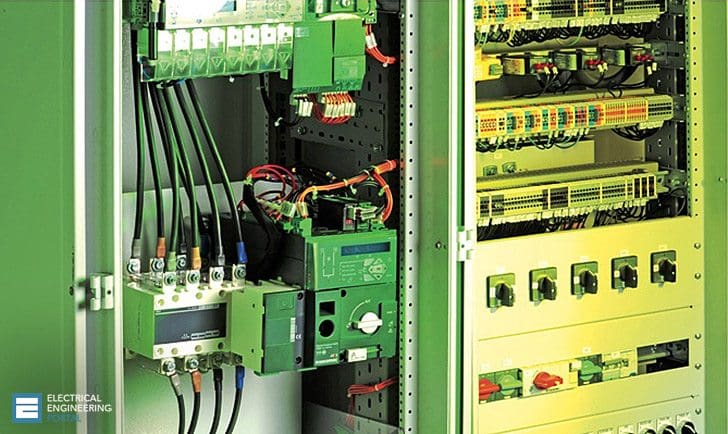
All electrical power consumed by the circuit, equipment, or system connected to the transfer switch output is defined as the load.
A typical transfer sequence includes following steps:
- The normal power source fails.
- When power from the generator or the backup utility feed is stable and within prescribed voltage and frequency tolerances, the transfer switch shifts the electrical load to the emergency power source. Depending on the facility’s needs and preferences, that transfer either occurs automatically or is executed manually.
- When utility power is restored, the transfer switch returns the load from the emergency power source to the normal one. Again, this can happen automatically or manually, depending on the type of switch being used and its operation mode.
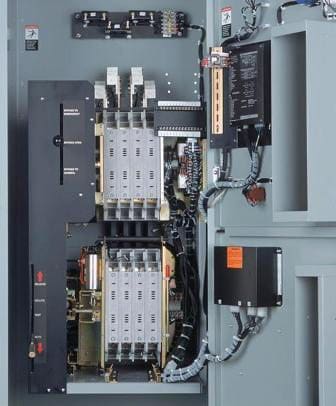
Two ways to transition loads
Transfer switches can transition loads between normal and emergency power sources in two basic ways:
The specific functions performed by a given load and the importance of those functions to safety or security play an important role in determining which kind of transition is required.
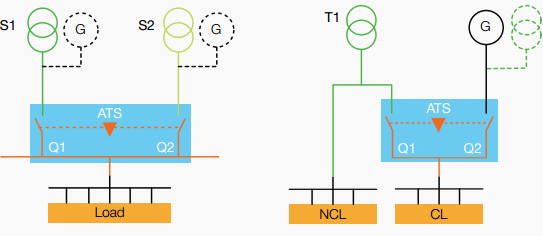
Where:
- CL – Critical load
- NCL – Non-critical load
- ATS – Automatic transfer switch
- Q1, Q2 – Circuit breakers
Open transition
An open transition is a “break before make” transfer. That is, the transfer switch breaks its connection to one power source before making a connection to the other. For some period of time between disconnection and connection, neither the normal power source nor the emergency source is providing electricity to downstream loads.
Open delayed transition //
In an open delayed transition, the transfer switch pauses in-between disconnecting from one power source and connecting to the other. That delay typically lasts either a specific, pre-set amount of time or however long it takes the load voltage to drop below a prespecified level.
Advantages
- Building a delay into the transition process can prevent higher than normal electrical current (also known as “inrush current”) from developing. Inrush current can occur when an inductive load is rapidly reconnected to a non-synchronized power source. It can be an issue in applications where a residual voltage is briefly maintained at the load due to the generator effect created by a rotating motor or by the stored energy released from a transformer’s windings or core.
- Operation is independent of electrical synchronization between both sources of power.
- A transfer between power sources can be initiated automatically or manually.
Disadvantages
- Unless some type of stored energy system, such as an uninterruptible power supply (UPS), is located downstream of the transfer switch, loads will experience a brief interruption in power during the transition delay period.
Open in-phase transition //
With open in-phase transitions, an automatic controller uses built-in intelligence to execute an open transition at the precise moment it expects the normal and emergency power sources to be synchronized in phase, voltage, and frequency.
If synchronization doesn’t occur within that time span, some transfer switches have the ability to default automatically to a delayed transition that serves as a failsafe.
Advantages
- The rapid transfer time means that a transfer is accomplished without an appreciable power interruption to the load, provided that the system is properly adjusted
Disadvantages
- In-phase transitions must be executed by an automatic controller. Manual operation is not possible as microprocessor logic is needed to manage source synchronization.
- If both sources of power are available but unable to meet pre-set synchronization criteria, and the transfer switch isn’t capable of defaulting to a delayed transition, a transfer will not occur.
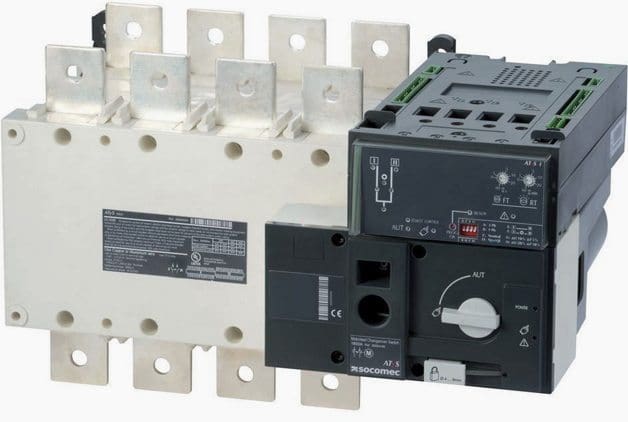
Closed transition
A closed transition is a “make before break” transfer, in that the transfer switch makes a connection to the new power source before breaking its connection to the old one. As there’s no gap between disconnection and connection, downstream loads receive continuous power throughout the transfer process.
The overlap period during which both sources are simultaneously connected, or “paralleled”, usually lasts no more than 100 milliseconds to comply with local utility interconnect requirements.
Advantages
- Critical loads can continue to operate, without an interruption in power, during loaded generator engine testing
- Energy costs can be reduced through “peak shaving”, which is the ability to control usage from a utility during intervals of high demand in order to limit or reduce demand penalties during a given billing period
- Depending on the application, may eliminate the need for a UPS to be located downstream
Disadvantages
- Transfer switches sophisticated enough to execute a closed transition tend to cost more.
- Some utilities require closed transitions to comply with interconnect requirements aimed at preserving power quality and protecting utility service personnel and equipment. In some cases, this can require the inclusion of protective relays in the electrical circuit
- Closed transitions must be executed by an automatic controller. Manual operation is not possible as microprocessor logic is needed to manage source synchronization
- Closed transitions can produce higher fault current, due to the 100 millisecond period when both power sources are paralleled. As a result, the consulting engineer may specify a higher withstand close-on rating (WCR), which could require oversizing the transfer switch amperage rating.
Reference // An introductory guide to picking the right transfer switch for your environment – Charlie Hume, Eaton





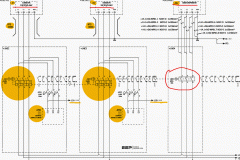





How does the instantaneous ats work? Any diagram illustration will be much appreciated or video. Thanks!
Is there any transfer swich for open transition switching like (I-0-II),but when you are in the 0-transition there is a connection between the load and “0” and it can serve as a grounding switch ?
hello
please give me information about changeover switch (make before break motorize) in below circuit Q01
WHAT KINDE OF SWITCH IN YOUR PRODUCT.
THANKS
Edvard, Well done on a clear article. With the increasing incidence of Load-Shedding occurring in many of the counties I work in, the question of Automatic-Change-Over from Supply Authority to Stand-By Generator is becoming normal practice.
Regarding the question of “what is critical and non-critical” loads it depends on the consumers operation. Is it a Hospital with life-support then it would be important to have this equipment to be un-interrupted i.e. UPS, if not then the process must be changed over ASAP.
If the consumer has critical materials in a process, say a glass-works or a plastics-works then the supply must be returned within a suitable time to prevent the product from solidifying in the moulds.
My main exposure is industrial installations where a plant runs 24/7 and a few minutes of power loss is acceptable as long as safety lighting is maintained via a UPS and with the advent of LED flood-lighting this is becoming simple to attain.
Most of my experience with stand-by generators allows for a change-over ATS using contactors with a suitable mechanical and electrical interlocking.
When there is load-shedding the generator is allowed to get up to voltage and the contactor for the generator comes in. (so the time lost is Generator start up time plus a few seconds.
Once the supply comes back on the generator continues to feed the plant for a pre-determined time to ensure that the supply authority supply is stable then the question is how do you switch back to the supply authority.
Most of the time there is a further Off sequence where the supply is disconnected from the generator, there is a time lag where any rotating equipment is allowed to wind down then the interlocked contactor system switches back to the main supply and the machine operators bring back the machinery to full operation.
With the advent of micro-processor change-over and the ability to monitor the supply and generator phase sequences there is a new generation of switches where the hand over is instantaneous and there is no loss of supply at this switch over sequence. Perfect synchronised hand over, no loss of supply and very little inrush current.
three types of loads non essential essential and critical….aron
To avoid high inrush can we switch on at a selected point in the wave form.